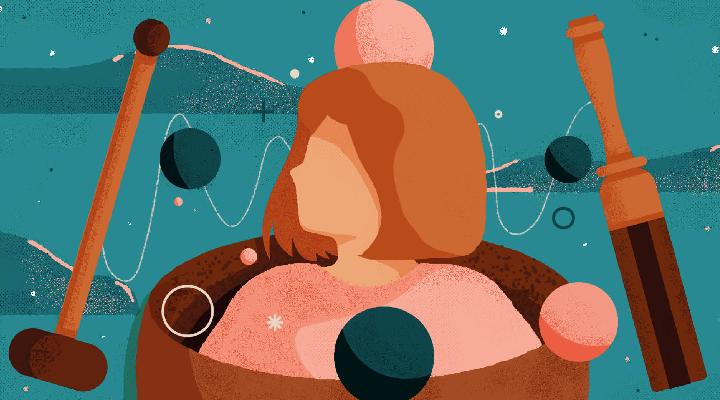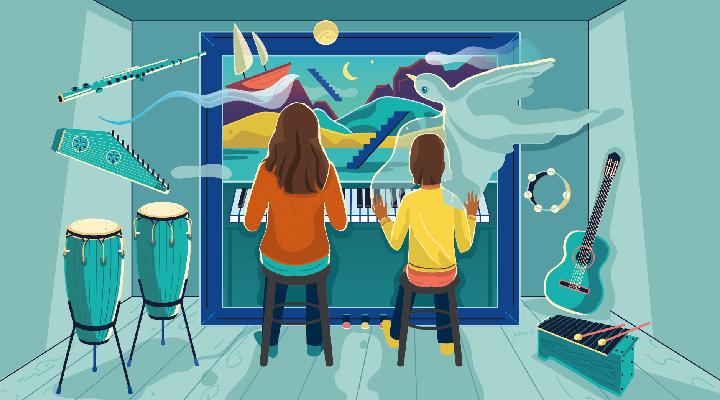We all know the benefits of listening to music. When we are stressed, listening to a piece of music by Kihan Kalher makes us relax and smile again. This can take us away from the machine life for a few minutes and lead us toward our feelings. This connection with emotions and creating a sense of relaxation has led to the invention of music therapy. You will learn more about this method and its types in this article.
What is music therapy?
The clinical use of music to achieve individual goals, such as reducing stress, improving mood, and expressing oneself, is called music therapy. This evidence-based method is well-established in the modern medical community. Music therapy is done in one of these ways:
- Listen to music;
- singing;
- playing an instrument;
- composition;
- to dance
- Talk about the music.
You don’t need musical skills or talent to do this.
Music therapy was first used in 1945 by the United States Department of War. This method helped wounded military personnel in US Army hospitals to recover physically through professional treatment, education, and recreation.
Types of music therapy
Music therapy may be an active process in which the individual plays or participates in creating the music. Sometimes this therapy is a passive method that involves listening or responding to music. Some therapists also use a combination of these two methods. In general, music therapy is divided into seven ways.
1. Analytical music therapy
Analytical music therapy encourages you to express your unconscious thoughts in the language of music through improvisation or improvisation. Then you can think about it and discuss it with your therapist.
2. Bennzon-style music therapy
In this method, some concepts of psychoanalysis are combined with creating music. “Ronald Bennzon” is a famous person in music therapy. This Argentinian therapist’s plan seeks to find your “musical identity” and the external sounds that describe your inner state of mind.
3. Cognitive Behavioral Music Therapy ( CBMT )
This method combines cognitive behavioral therapy or CBT with music. In cognitive-behavioral music therapy, music strengthens some behaviors and modifies others. This method is purposeful rather than improvisational and may include listening to music, dancing, singing, or playing an instrument.
4. Social music therapy
In this style, music facilitates change at the community level. This is a group method and requires the active participation of all group members.
5. Treatment by Nordoff-Robbins method
This form of treatment is also called “creative music therapy.” In this method, the patient plays the instrument (often cymbals or drums), and the therapist accompanies him with another device. Improvisation turns music into a way to express oneself and one’s feelings. The Nordoff-Robbins Foundation, established in 1958, is the originator of this method. This music therapy is more beneficial for children and helps those with physical or mental disabilities.
6. Simulation and guided music ( GIM ) by Bonnie’s method
This form of therapy uses classical music to stimulate people’s imagination. In this way, you describe the feelings, memories, and images that come to you when you listen to music.
7. Phonetic psychotherapy
In this method, you use various phonetic exercises, natural sounds, and breathing techniques to communicate your feelings and sudden urges. These exercises are used to establish a deeper connection with yourself.
The difference between ava therapy and music therapy

Sometimes these two methods are confused with each other while they are different. Each style has its own goals, protocols, tools, and requirements. The differences between these two methods are:
- Music therapy is a field that has received more attention recently, but ava therapy has its roots in ancient cultural practices in Tibet.
- Avatherapy uses tools to reach specific sound frequencies, while music therapy focuses on treating problems such as stress and pain.
- The validity of ava therapy training and certifications is not the same as that of music therapy.
- Music therapists often work in hospitals, addiction treatment centers, or private treatment centers, but audio therapists sometimes offer their services as part of or as an alternative to treatment methods.
Music therapy in psychology
Music therapy is suitable for people of all ages. This method helps even minors. Music therapy works for people with any level of knowledge about this art.
1. Music therapy for depression
According to research, this adjunctive therapy can become a practical part of depression treatment. By combining this style of therapy, antidepressants, and psychotherapy, people with depression recover best.
2. Treatment of obsessive-compulsive disorder ( OCD )
This adjunctive therapy method, along with other forms of treatment, may help reduce obsessive thoughts, depression, and anxiety in people with OCD.
3. Reducing insomnia
Many people find that music or even white noise helps them fall asleep. According to research, music therapy can help people with sleep disorders or insomnia as a symptom of depression. This method is less invasive and cost-effective than drugs and other standard treatments. Anyone can take help from it to control their situation.
Physical benefits of music therapy
The benefits of music therapy for improving physical health have not been researched as much as their benefits for mental health. However, the results of using this method so far are encouraging. The most acute effects of music therapy on the body are:
- Lower blood pressure.
- Reducing muscle tension and pain.
- Distraction from chronic pain, childbirth, or post-surgery pain.
- Increase in natural killer (NK) cells.
- Reduce asthma attacks.
- Helping premature babies gain weight and sleep comfortably.
- Improve sleep habits.
- They are helping patients with Parkinson’s to improve motor functions.
Music therapy and improving conditions of cancer patients
This therapy method is helpful for families who have cancer patients. Few people go through cancer alone and in isolation, and some survivors believe the cancer experience was harder for their loved ones than for themselves. Yes, cancer affects people’s families too, but the needs of cancer patients’ families are often forgotten.
Based on research on these families, music therapy at home improves the mood of cancer patients and their families. The feeling of helplessness is an enormous discomfort for the cancer patient’s family. In this study, families who cared for cancer patients experienced a kind of happiness called “nurse happiness.” These nurses gained a sense of empowerment with the help of music. They were able to do something for the patient during his life. After his death, listening to this music gave them a sense of happiness and connection with the deceased person and filled them with happy memories and hope.
How is music therapy performed?

Talking to your doctor or therapist about this treatment method would be best. They can introduce you to the best music therapy centers.
The duration of music therapy depends on your goals and may last from 30 to 50 minutes. These sessions can be scheduled like psychotherapy sessions. You can choose time intervals, such as once a week, to hold these meetings. The music therapist determines the amount and time of these courses based on your conditions and needs.
Talking to your music therapist before the first music therapy session is better. Say your expectations in this conversation. You may also conclude that you should consult your doctor about this issue. For example, if you have a hearing problem, use a hearing aid, or have had a cochlear implant, you should talk to your doctor before this session. He is the one who determines whether music therapy is a risk for you or not.
In addition, if music therapy is combined with dance and movement, it is unsuitable for those who cannot exercise due to pain, illness, or physical injury.
Does music therapy have side effects?
In answer to this question, it should be said that music therapy may also have side effects. Music therapist researchers believe that to use this method, one should pay attention to each patient’s condition, medical history, culture, and age. For example, it is not wise for music to make a patient dance after surgery. It is also best to avoid listening to music that reminds you of an unpleasant phase in your life. However, it seems that the positive effects of music outweigh its side effects.
you say
Contrary to popular belief, music therapy is a science that has a long history. With the help of music, this science helps to improve people’s moods and relieve their pain. There are many people who, after music therapy, music has become an integral part of their lives.
What role does music play in your life? Have you ever used music to forget your pain? Do you think music therapy can help reduce physical and mental pain?
Warning! This article is only for educational purposes; to use it, it is necessary to consult a doctor or specialist.



